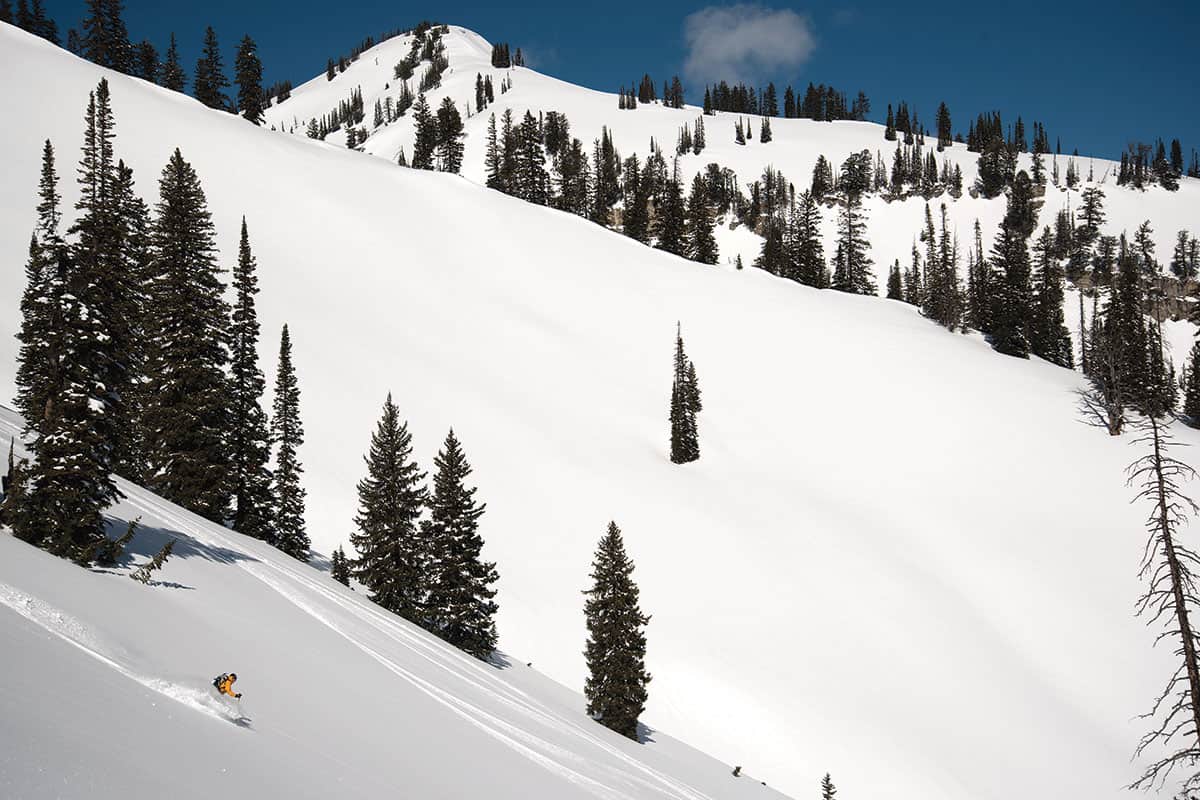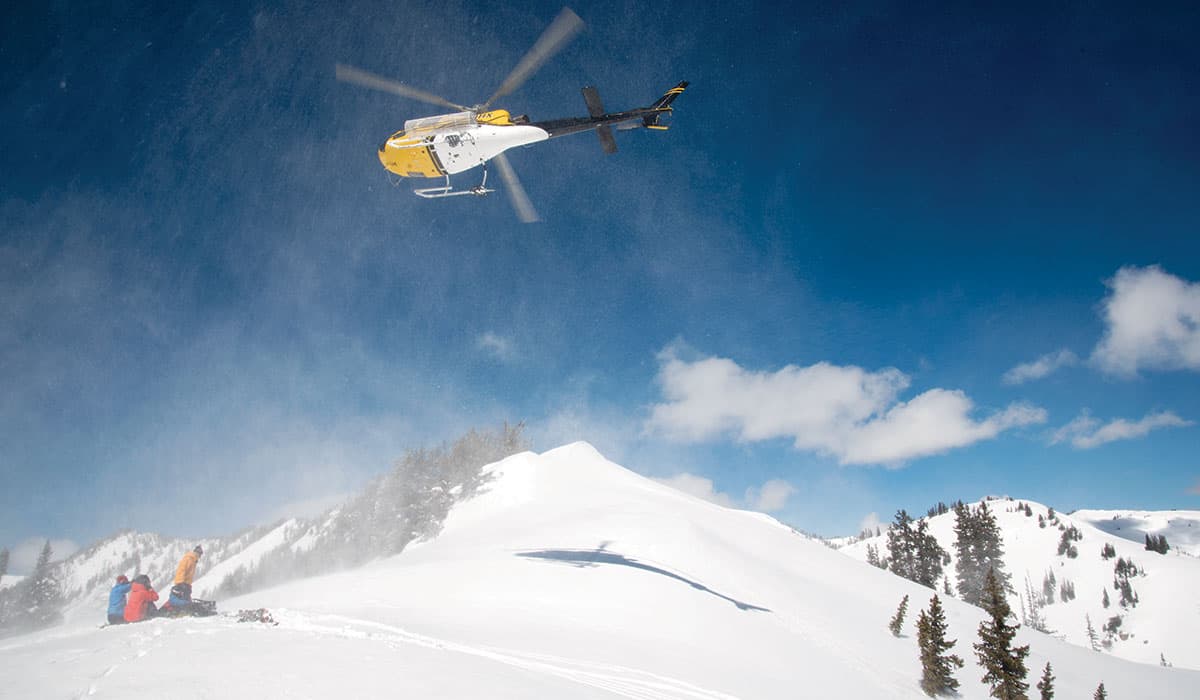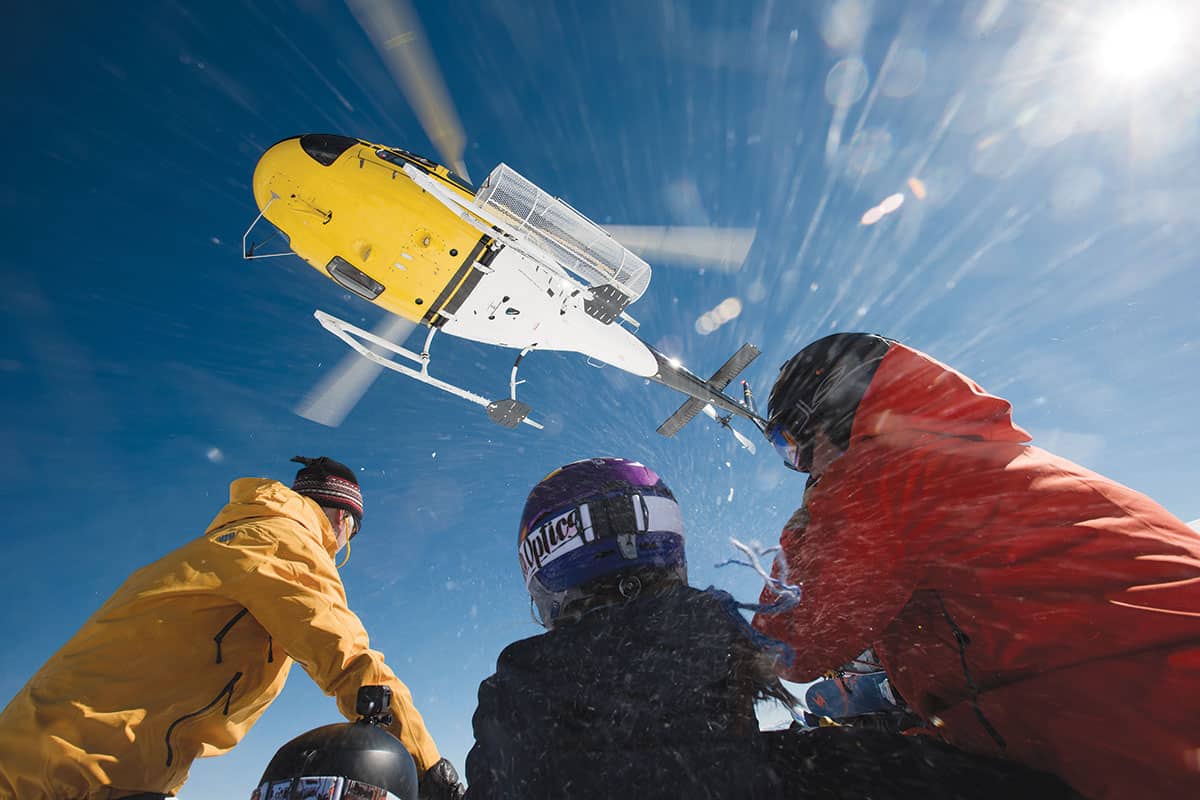Read The
Current Issue
Heli Yes!
For the ultimate ski day, try heli-skiing.
By Frederick Reimers
photography by Bradly J. boner

IF YOU’VE EVER skied a slope of untracked powder, you don’t need me to explain the appeal of helicopter skiing. If you’ve ever ridden in a helicopter before, you don’t need me to tell you that flying in one through the mountains might even be the better part of the heli-ski experience.
The question about heli-skiing is not whether you should go, but what you’re willing to do to afford it. Thinking about buying a new pair of skis and bindings this winter? I’d put that money toward heli-skiing. Planning on putting the kids in ski school for the week? How about you go heli-skiing while they figure it out on their own? High Mountain Heli-Skiing is Jackson Hole’s lone helicopter-skiing outfit; they’ve been at it since 1974. For $1,350, you get six guided runs on untracked slopes somewhere in the Snake River, Palisades, Hoback, Teton, or Gros Ventre mountain ranges.
Even a bad day heli-skiing is good, but the day I went last February was stellar.
ON THAT DAY, I find myself buckled in shoulder to shoulder in the back of an AS350 B3e AStar helicopter with three other clients: two Frenchmen named Alex and Caesar, sales managers for a fancy Swiss watchmaker; and Bobby, an orthodontist from North Carolina. Guide Charlie Cornell sits in front with the pilot. The heli is so loud that we are each alone in our thoughts; I’m thinking I can’t remember the last time I was so giddy. Skimming treetops, it’s remarkable how much this feels like the flying I’ve done in dreams. Swooping toward the mountain where we’ll land for our third run, the helicopter flares upwards and then sets down so gently I can’t tell when exactly its skids touch.
We pile out and, just as Charlie showed us earlier, huddle in a clump on the snow well clear of the dangerous blades. Charlie unloads our skis and snowboards from a steel basket bolted to the side of the aircraft. After it lifts skyward and flits downslope, we stand up, shaking off the roar of the engine and blinking at the ramparts of snow-covered peaks in every direction.
Below us lies an untracked slope. Black-diamond steep and the width of a city block, it plunges for a thousand unbroken feet to a treed ridge below. “This one is called Main 101,” Charlie says. “It’s 101 turns to the bottom.”
Charlie is loosening up. Early on, he was as serious as a block of ice, which, really, is what you want in a helicopter ski guide. He’d sternly directed us on how to get in and out of the helicopter without getting chopped in half (or kicking a hole in the $2 million craft), and told us where and how to stand while he dug a pit in the snow to assess the avalanche hazard. “I need to take a leak. Mind if I scoot over to those trees?” I had asked. “You can do it right there,” Charlie replied, as he threw shovelfuls of snow below him. I held it, not wanting to splatter my new friends.
Now, though, as Charlie drops into Main 101, he shouts, “Oh yeah!”
That sounds about right to me. The snow is unusual—a four-inch-thick layer of graupel, BB-size balls of ice that ski like a mix of powder and perfect spring corn. It’s hero snow. As much as I want to play it cool, I can’t help but crack a grin.
If there are one hundred turns here, that breaks down to about two dollars a turn. I don’t want to waste a single one and slide each arc with deliberate care. Alex, on the other hand, skis with gusto. A former ski racer, he slashes huge turns, picking up speed and hopping a roller. He lands and tomahawks headfirst into the snow. Alex comes up with his helmet and goggles crammed full, but grinning. “Nothing puts a smile on my face like that,” he says.
At the bottom of the bowl, we’re not finished. We pop onto a knife-blade ridge and slash turns down either side of it. We don’t stop until the flat meadow at the bottom of the ridge. (The meadow is the same spot the helicopter has picked us up after each run so far.) We stop one hundred yards from another waiting group.
They are clustered together with their skis in a pile. One helicopter serves three groups each day out, and High Mountain typically runs two helicopters a day.
“We’ve got 305,000 acres of terrain permitted,” Charlie says. That’s 122 times larger than Jackson Hole Mountain Resort. “We can always find fresh tracks,” he says.
If there are one hundred turns here, that breaks down to about $2 a turn. I don’t want to waste a single one and slide each arc with deliberate care.
BECAUSE JACKSON HOLE is ringed by wilderness and national parks, where helicopters are forbidden, the area where High Mountain operates is south of the valley. Their permit covers all of the Snake River and Palisades ranges, and parts of the Tetons, Hobacks, and Gros Ventres. We’re in the Snake River Range.
Groups fly out of the Snake River Sporting Club, thirteen miles south of Jackson, or Teton Springs Resort, just over Teton Pass in Victor, Idaho. Both are in the northern end of the Snake River Range. Guests can drive themselves to a meeting spot, or High Mountain can arrange complimentary transportation.
After another run, we hang out and eat lunch in the sun while the helicopter flies back to the heli-base to refuel. One of the other groups, a pair of young couples, starts a playful snowball fight with us. Charlie describes moving to Jackson a week after college and never leaving. “That was twenty-five years ago,” he says. It’s a typical story around here. In the summer he guides fly-fishing trips or works as a carpenter. If heli-ski guiding were my job, I’d do whatever it took in the summer, too.
Near the bottom of our fifth lap, Charlie announces that it’s time for the group to decide if they want to order up extra runs. “We can do more, but it’ll cost you,” he says. Additional bumps are $140 a pop. The Frenchmen are on board, as am I. Six heli runs are like a ten-minute massage—not enough. All eyes turn to Bobby. “Why not?” he says. Pumping their fists, Alex and Caesar break into a cheer of “USA! USA! USA!”
Our last landing is a spicy one. Alex is in the right window seat. He looks out at the ground and turns to us with his eyes wide, pointing toward the back of the helicopter. I assume he is excited about the run below, but when I climb out, I see that the back half of the helicopter’s skids are hanging into space off a tall cornice.
Alex had been worried we were going to plunge backwards off the mountain, chopper and all.
Neither the pilot nor Charlie look worried, though. Once he has unloaded our skis, Charlie gives the pilot a wave, and the helicopter roars off down the hill to wait for us 2,500 feet below.




Nuts & Bolts
High Mountain Heli-Skiing’s season is dependent on conditions and usually runs from December to March. Cost is $1,350 per person, per day. This includes six runs and lunch. Additional runs are $140 per person, per run. 307/733-3274; heliskijackson.com




